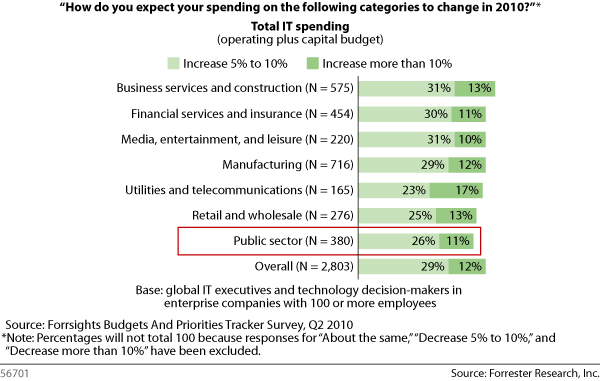Getting Smarter? Yes. Public Sector Does Expect To Spend More On Technology.
Last week I was in Dubai and got a chance to visit GITEX, the largest IT event in the Middle East. I was very interested and impressed to see the “Government” pod. I’ve participated in many IT events including biggies like Mobile World Congress, and I don’t think I’ve ever seen a pod dedicated to governments’ use of IT. But, the event in Dubai clearly was showcasing how governments were using IT to address public sector concerns. I spent time in the UAE Ministry of Public Works (MoPW) booth hearing about their “e-Project” portal, which streamlines processes such as bidding and awarding of MoPW contracts, as well as the prioritizing, managing, and launching of specific projects. The portal also facilitates the registration, licensing and evaluation of vendors. The Ministry of the Environment and Water also recently launched a new version of its Web portal, which welcomes suggestions or complaints from citizens and employees, allows for public inquiries about all conservation and environmental projection issues, enables licensing for agricultural business activity or use of pesticides, and even includes a “contact the minister” feature. I also spoke to teachers affiliated with the Dubai Ministry of Education who were thrilled to have just received new iPads from which they could take attendance, record grades and manage classroom schedules. Many ministries and government agencies from across the UAE were represented. Clearly Emirates cities understand the imperative of addressing public issues with technology solutions. As populations grow – UAE population will increase 75% between 2010 and 2050 – and development continues, Emirati governments are getting “smart.”
 With growth expected to return to Dubai and with others in the region well-endowed with oil revenues, these cities and countries can afford to invest and get “smart.” In other regions, cities are not as lucky. However, many are still finding ways to invest in technology – for competitive reasons to attract and retain new businesses and residents and to address the needs of a rapidly exploding population. In fact, well over one-third of respondents in Forrester's Forrsights Budgets And Priorities Tracker Survey, Q2 2010 indicated that they would increase IT spending by at least 5 percent, 11 percent said that they would increase by more than 10 percent. While fewer public-sector respondents reported increases than in other industries, the results do indicate IT spending. A couple of weeks ago in a blog entitled “Taking Lessons From Smart Cities,” I wrote about some of the business models that enable this IT spending: revenue or risk sharing, collaborative purchasing options and reselling excess capacity. What the governments are spending on and the creative ways through which they are finding the money are discussed in more detail in my newly released report, entitled “Getting Clever About Smart Cities: New Opportunities Require New Business Models.”
With growth expected to return to Dubai and with others in the region well-endowed with oil revenues, these cities and countries can afford to invest and get “smart.” In other regions, cities are not as lucky. However, many are still finding ways to invest in technology – for competitive reasons to attract and retain new businesses and residents and to address the needs of a rapidly exploding population. In fact, well over one-third of respondents in Forrester's Forrsights Budgets And Priorities Tracker Survey, Q2 2010 indicated that they would increase IT spending by at least 5 percent, 11 percent said that they would increase by more than 10 percent. While fewer public-sector respondents reported increases than in other industries, the results do indicate IT spending. A couple of weeks ago in a blog entitled “Taking Lessons From Smart Cities,” I wrote about some of the business models that enable this IT spending: revenue or risk sharing, collaborative purchasing options and reselling excess capacity. What the governments are spending on and the creative ways through which they are finding the money are discussed in more detail in my newly released report, entitled “Getting Clever About Smart Cities: New Opportunities Require New Business Models.”
I look forward to any comments, and to continuing to learn about new “smart city” initiatives. And, don’t forget to join us for our Smart Cities Tweet Jam on November 9th from 11:00am to 12:00pm EDT (8:00am to 9:00am PDT and 5:00 to 6:00pm CET), using the Twitter hashtag #smartcityjam.